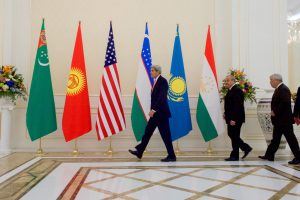Next week U.S. Secretary of State Antony Blinken will make his first trip to Central Asia, stopping in Kazakhstan for a meeting with the region’s foreign ministers in the C5+1 format and visiting Uzbekistan on February 28 and March 1 before flying onward to India to attend a G-20 Foreign Ministers’ Meeting, a Quad meeting, and the Raisina Dialogue. While in Central Asia, Blinken will meet bilaterally with each Central Asian foreign minister and also with the Kazakh and Uzbek presidents.
In a call with journalists, Assistant Secretary of State for South and Central Asian Affairs Donald Lu underscored that while this will be Blinken’s first trip to the region it will be his fourth meeting within the C5+1 format with the region’s foreign ministers.
The format, first launched in 2015, brings together the five Central Asian foreign ministers with the U.S. secretary of state. The United States is not alone in approaching Central Asia regionally: Japan has done so since 2004 with its Central Asia Plus Japan format, Europe has held at least 18 EU-Central Asia Ministerial Meetings, China launched its own C5+1 in 2020, and so did, paradoxically enough, Russia.
Lu acknowledged that the upcoming C5+1 comes against the backdrop of the one-year anniversary of Russia’s invasion of Ukraine. On February 23, 2023, the U.N. General Assembly voted on a resolution calling on Russia to end the war and leave Ukraine. While the resolution was overwhelming approved — 141 to 7 — among the 32 abstentions were all five Central Asian states and India, the destinations of Blinken’s upcoming trip.
When asked about this area of friction, Lu was frank: “It’s clear to us that the countries of Central Asia, and India, have had long, complex relations with Russia. I don’t think they are going to end those relations any time soon, but we are talking to them about the role that they can play in this conflict.” Lu then highlighted the large amounts of humanitarian aid Central Asian countries and India have sent to Ukraine and their speaking out regarding territorial integrity, independence, and sovereignty (the “holy trinity” in U.S. relations with Central Asia).
“We may not share the same approach every day on Ukraine, but we do share the goal that this conflict end based on the principles of the U.N. charter,” he continued.
More broadly, Lu stressed that the United States was not seeking to ask the countries of Central Asia, or the Indo-Pacific, to choose between the United States and Russia and China. “Instead we are interested in showing that United States has something to offer, that we can be a reliable partner,” he insisted.
“I do think the countries there want to see a role there for the United States, for Europe, for Turkey, because they can see that we have something to offer in terms of engagement, economically, but we also have something to offer in terms of the values that we bring to the table,” he added. “We’ll have that on display during the secretary’s visit.”
When it comes to values, the United States is arguably on shaky ground in Central Asia. None of the Central Asian states, for example, were invited to the Biden administration’s Summit for Democracy in 2021 (and it is a good bet none will be invited to the upcoming follow-on summit in late March). Kazakhstan’s most recent snap presidential election in November 2022 was “efficiently prepared” but “lacking competitiveness,” according to an Organization for Security and Cooperation in Europe (OSCE) monitoring mission report, and the country’s upcoming parliamentary election, also a snap election, is expected to be much of the same.
Beyond politics, all five Central Asian states struggle with freedom of speech issues, in particular. It’s notable that the Kyrgyz government is currently attempting to push out RFE/RL, a U.S. government funded media network that provides detailed coverage of the region in local languages.
There’s nothing new about these difficulties, however, and it seemed from Lu’s comments that the United States remains interested in pursuing engagement with the region, with an eye on the geopolitical. He said the secretary’s upcoming trip will “draw a line under how our engagement is different from the engagement of Moscow and Beijing.”
Returning to the Ukraine war and its implications, Lu said Washington has had some clear successes in helping the region navigate the economic difficulties of the war, particularly the impact of sanctions. In Kazakhstan, for example, the U.S. has issued a license to smooth the export of Kazakh oil via the Caspian Pipeline Consortium (CPC) pipeline, which runs through Russia. The purpose of sanctions, Lu said, was to target Russia’s war machine, “not to harm the interests of Central Asia republics, their peoples or their economies.”
Blinken’s brief trip to Central Asia next week may ultimately be subsumed by news related to the second half of the trip, particularly the G-20 Foreign Ministers’ Meeting in New Delhi, which the Russian and Chinese foreign ministers are expected to attend as well. That said, it’ll be worth watching closely how Blinken, and the United States, navigate a values-based foreign policy through the autocratic waters of Central Asia. There are certainly opportunities for the United States to present itself as an additional partner to the region, but the Central Asian capitals will have their own agendas, too.
A final note: In the recent call with journalists ahead of Blinken’s trip, for the first time in perhaps two decades, the topic of Afghanistan did not arise in a conversation about Central Asia.
































